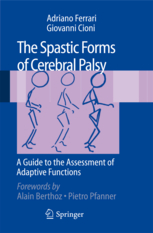This book is the result of studies on cerebral palsy (CP) in children that the authors and their collaborators (medical
doctors and therapists) have carried out in recent years.
It addresses the main topics associated with the evaluation of adaptive functions in the spastic forms of CP
(definition and modifications over the most recent decades, newly classified orientations, etiopathogenesis, anatomic?
functional correlations, semiotics, and the so-called associated disorders: visual, cognitive, and behavioral). The
main goal of this book is to offer readily accessible information on the nature of the disease, the problems correlated
with prognosis, and the rehabilitation.
The text is complemented with a DVD with clinical cases subdivided according to classifications proposed by the
authors. Because of its instructive nature and practical approach, the book will be an invaluable tool for
practitioners already working in this field (medical doctors, child neuropsychiatrists and physiatrists, and
rehabilitation therapists), for university students studying physical and occupational therapy, and for residents in
rehabilitative medicine, child neurology, and orthopedics.
PART I Nature of the Defect.- 1 Cerebral Palsy Detection: from John Little to the Present.- 2 Guide to the
Interpretation of Cerebral Palsy.- PART II Function Analysis.- 3 Functional Diagnosis in Infants and in Very Young
Children: Early Predictive Signs.- 4 Motor Defects.- 5 Perceptive Defects.- 6 Praxic Organization Disorders.- 7 Visual
and Oculomotor Disorders.- 8 Neuropsychological Evaluation.- 9 Emotional, Behavioral and Social Disorders in Children
and Adolescents with Cerebral Palsy.- 10 Observing Interactions.- PART III Classification of Spastic Syndromes and
Clinical Forms.- 11 Critical Aspects of Classifications.- 12 Kinematic Classification.- 13 Tetraplegic Forms.- 14
Dysperceptive Forms.- 15 Forms of Diplegia.- 16 Forms of Hemiplegia.- Subject Index


